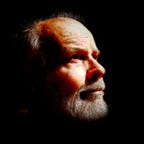Thanks Katie for the mention! I love your "dryer lint" idea! That will get some more thoughts going. As to connecting it to the AI use, it could get really complex.
Some folks create "art" by picking up fallen leaves, placing them on a blank paper, and spraying paint at and around them, which of course is blocked by the leaves. If you repeat this process many times, you can get an arrangement of those shapes which could be interesting or boring, or confused looking, or aesthetic even. We would credit the person doing the work with a degree of creativity, depending on our response to the results.
I spent years developing flame fractals which are images built on math functions and operate in the realm of Chaos theory. Many of the results are truly interesting and beautiful. I even wrote some of the formulas as a means of generating new styles that reflected the types of formulas that I used. This too seems like a type of "dryer lint."
I've attempted a few graphic images with AI tools, and they are at once easier to elicit an identifiable image, yet quite difficult to get exactly what I might have wanted. That last factor is often said of the fractals too.
Suppose one creates a thousand AI images, and selects a small portion of the image to use as some input texture for another AI image. At the end, regardless of the lack of control for image generation, the result might be quite well defined by my choices of specifics along the way.
This would at once randomize and distance my efforts from any original source material scraped from the web. It would give me a chance to shape portions of and indeed the whole of my final results. Does this render it a kind of genuine piece of art, worthy of a copyright? How far does one stretch the process to reach that definition?
I've not attempted such a project, but in exploring the theory here, at some point it seems that the AI process would become a genuine "brush" tool and the results might be something very removed from what we think of today as a "downside" to the AI process.
How might such a process be differentiated from developing a collage with leaf outlines, or throwing spoonfuls of paint at a canvas, or burning collected lint in such a way that it stains some paper it's laid on while burning? Some of the results of those methods could be copyrighted, but the AI version could not be per current rules.
I'm just thinking aloud here, and wondering what sort of rules would be needed to insure that genuine human creativity is the source of some end result?
It does seem to come down to a degree of honesty on the part of the artist, but I'm leaving these suggestions as open ended. If such a thing were attempted in a written story, I'd expect a disclosure of the process by the "author."
I would tend to accept such work in graphics, and be less welcoming of similar efforts for a written work. They're using AI for music now too. There's no avoiding the fact that these questions will pursue us in the coming months and years in today's world!
